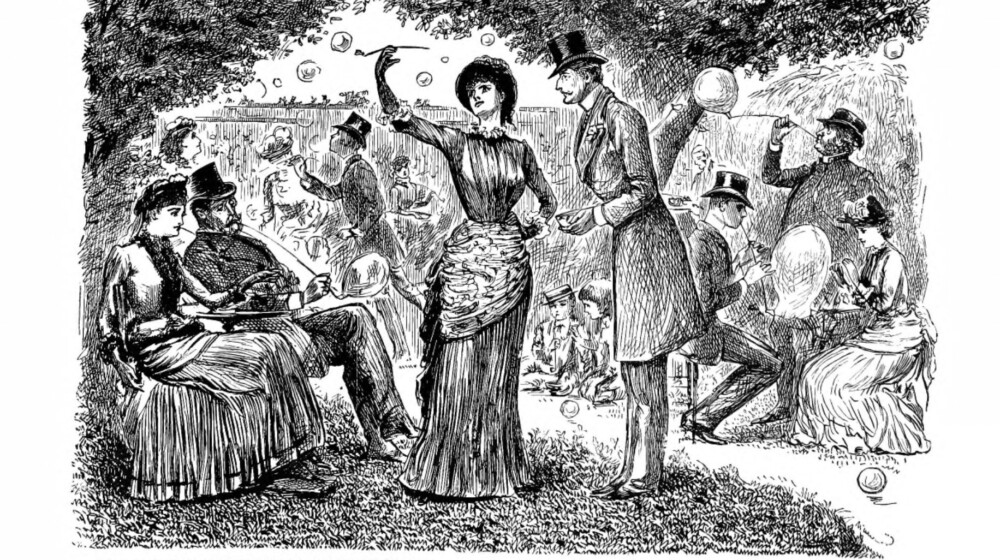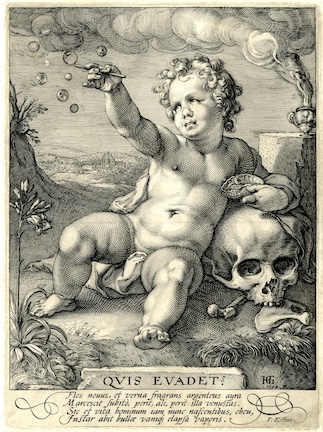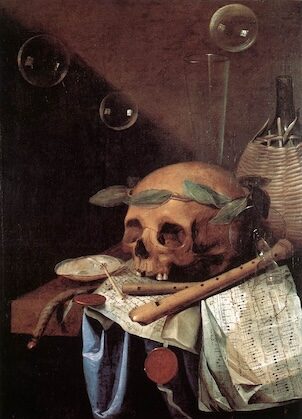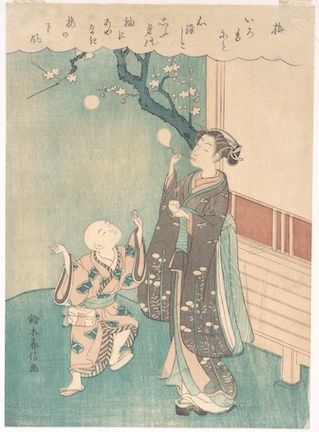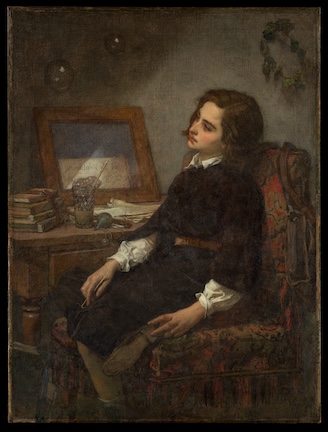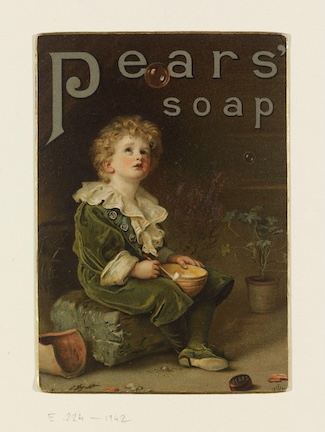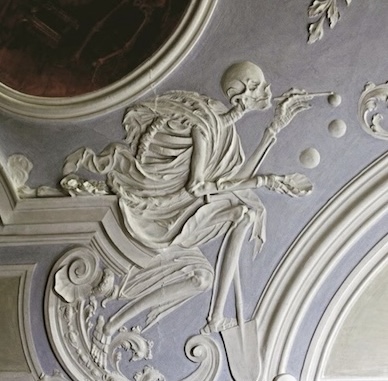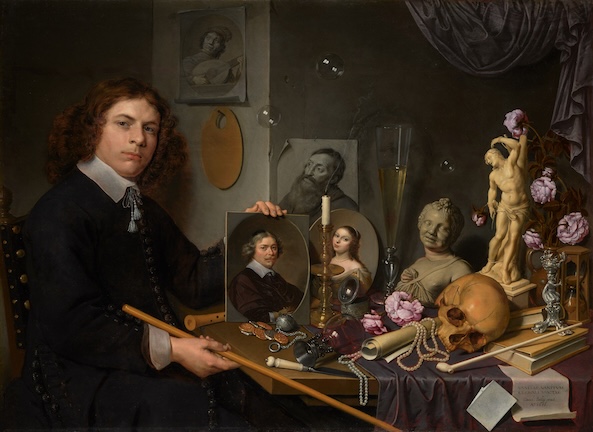“A soap-bubble is the most beautiful thing, and the most exquisite, in nature…
I wonder how much it would take to buy a soap-bubble, if there was only one in the world?”
– Mark Twain, A Tramp Abroad (Vol 2), 1880
Bubbles
For a printable version of this article, please click here.
Did you know…
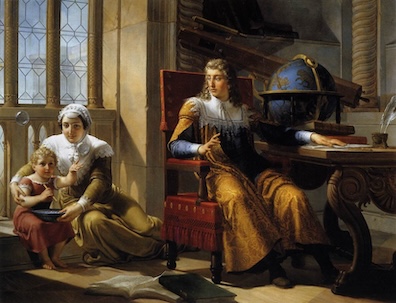
Newton’s Discovery of the Refraction of Light (with bubbles!), Pelagio Palagi, 1827
People have studied, written about, been inspired by, and, yes, played with bubbles for thousands of years. Bubbles are found in nature, and soap (with its corresponding plethora of bubbles) is thought to have been invented by ancient Sumerians around 5,000 years ago. That’s a lot of time for bubble inspiration! Ancient philosophers like Marcus Terentius Varro (Rome) and Lucian of Samosata (Greece) compared the fragile and temporary nature of bubbles to that of human life – a concept that recurs throughout history. Sir Isaac Newton studied the colors and light refraction of soap bubbles, and in the process discovered that their walls can be up to 4,000 times thinner than a piece of paper (!!). Sir Francis Bacon referred to the world as a bubble in a poem, again stressing the impermanence of life. Joseph Plateau studied the curvature and volume of bubbles. Sir William Thompson, Lord Kelvin (the man who proposed the absolute temperature scale) studied the mathematics of bubble foam. Mark Twain wrote about how beautiful soap bubbles were, and artists were inspired by that exquisite beauty.
-
More Info: Business Bubbles

Reproduction of a card satirizing the South Seas Bubble, 1825, held by the British Museum
“Double, double toil and trouble; Fire burn and cauldron bubble…”
– William Shakespeare, “Song of the Witches” from MacBeth, 1606-07The word “bubble” has been used in economics for over 300 years as a metaphor for over speculation in a commodity, stock, or an entire market, where the price is drastically inflated far beyond its real value. And, as we all know, bubbles have a tendency to pop.
In 1720, the ‘Bubble Act’ was passed by Parliament in England, shortly before the South Sea Bubble – the economic collapse of the South Sea Company that rocked England and the London Stock Exchange. It wasn’t the first market bubble that failed, though. That dubious honor supposedly goes to the “tulip mania” bubble in the Netherlands in 1637. Closer to our time, the 1929 stock market crash we discussed in our last blog article, Arizona and the Great Depression, was also an economic bubble that collapsed. And more recently, we have the Dot Com bubble that burst in 2000, and the Real Estate bubble that popped in 2008.
Other “bubble” sayings or meanings:
- On the bubble
- In a bubble
- Speech bubble
- Bubble boy
- Bubble up/over
- Bubble under
- Bubbly
- Bubbler
- Bubble head
- Burst someone’s bubble
And, of course, just a few years ago (and hopefully never again!) we were “in the bubble” with the COVID bubble.
The first known paintings of people blowing bubbles are from 16th century Danish artists Pieter Bruegel the Elder (Children’s Games, 1560) and Cornelis Ketel (a cherub on the back panel of a Portrait of Adam Wachendorff, with the Greek words “Πomφolyξ O anθpωπoσ,” meaning “Man is a bubble,” written at the top of the frame, 1574). These two paintings – one showing bubbles as a child’s plaything, and the other as an allegory of the transience of life, seem to be fairly typical of the ways soap bubbles were included in art, and some included both. More bubbles in art, up through the Victorian Era:
It’s through works of art like these that we know how people interacted with bubbles over 300 years ago – generally with bowls of soapy water and reed straws or clay pipes. The addition of glycerin to soap after its discovery in 1779 made it easier for skin to absorb and retain moisture, but also had the great side effect of making soap bubbles last longer. In 1890 the Pears Soap company used this to their benefit when marketing their glycerin soap, purchasing the rights to the John Everett Millais painting, “A Child’s World,” renaming it “Bubbles,” and using it in many of their soap ads.
 Early in 1880, a handful of newspapers in Great Britain reported on several “soap bubble parties,” including one hosted by an American in Paris who wanted to get in on the fun. A couple of weeks later, the news started spreading throughout the US, and a few months later this “novel entertainment” was reportedly being enjoyed in fashionable circles along the East coast and beyond (as seen in the image at the top of the page). Some welcomed the parties as a “delightful pastime,” and others as a “childish amusement for adults” (a grumpy statement we found in the November 28, 1897 Arizona Republican newspaper). A soap-bubble party would consist of bowls with a warm bubble solution that included extra glycerin; a clay pipe for each guest, decorated with ribbon; and hand fans to blow the bubbles around. Hosts gave out prizes for the biggest bubble, the bubble that popped last, and the bubble that reached the highest or furthest point. Parties could be set up inside or outside, and even along tennis courts so the attendees could try to blow bubbles back and forth across the net. The best parties also had refreshments, music, and dancing. Newspapers and magazines reported on bubble parties, and had suggestions for hosting your own, for adults and/or children.
Early in 1880, a handful of newspapers in Great Britain reported on several “soap bubble parties,” including one hosted by an American in Paris who wanted to get in on the fun. A couple of weeks later, the news started spreading throughout the US, and a few months later this “novel entertainment” was reportedly being enjoyed in fashionable circles along the East coast and beyond (as seen in the image at the top of the page). Some welcomed the parties as a “delightful pastime,” and others as a “childish amusement for adults” (a grumpy statement we found in the November 28, 1897 Arizona Republican newspaper). A soap-bubble party would consist of bowls with a warm bubble solution that included extra glycerin; a clay pipe for each guest, decorated with ribbon; and hand fans to blow the bubbles around. Hosts gave out prizes for the biggest bubble, the bubble that popped last, and the bubble that reached the highest or furthest point. Parties could be set up inside or outside, and even along tennis courts so the attendees could try to blow bubbles back and forth across the net. The best parties also had refreshments, music, and dancing. Newspapers and magazines reported on bubble parties, and had suggestions for hosting your own, for adults and/or children.
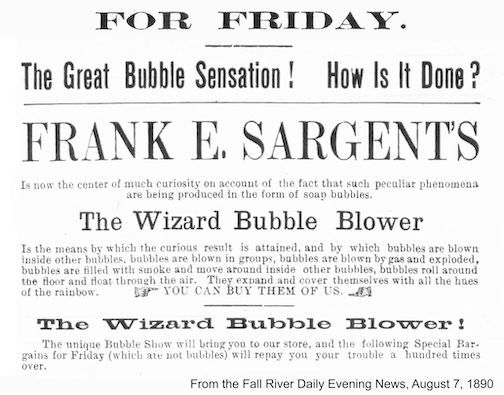 There also were a series of vaudeville bubble acts around the first quarter of the 20th century, billed in newspapers as “soap bubblers”, and soap bubble “wizards”, “manipulators”, and “jugglers”. The three acts that show up in newspapers throughout the US were Happ Handy & Co., Ollie Young & Miss April, and Frank & Clara LaTour (also known as the La Tour Trio, likely performing with a relative). They would combine blowing bubbles with music, comedy sketches, juggling, boomerang throwing (exclusive to the Ollie and April act), and more. The “bubble manipulating” parts of their acts included blowing bubbles within bubbles; blowing smoke into bubbles, cutting them in two, and then rejoining them without losing any of the smoke; juggling bubbles; playing billiards with bubbles, and filling bubbles with a combustible gas and igniting them (exclusive to the Ollie and April act); and playing badminton with bubbles and rolling them in a line down a string (exclusive to the Happ Handy act). We could find only the La Tour Trio appearing on stage in Arizona, at the Columbia theater with several other vaudeville acts (Arizona Republic, December 4, 1925).
There also were a series of vaudeville bubble acts around the first quarter of the 20th century, billed in newspapers as “soap bubblers”, and soap bubble “wizards”, “manipulators”, and “jugglers”. The three acts that show up in newspapers throughout the US were Happ Handy & Co., Ollie Young & Miss April, and Frank & Clara LaTour (also known as the La Tour Trio, likely performing with a relative). They would combine blowing bubbles with music, comedy sketches, juggling, boomerang throwing (exclusive to the Ollie and April act), and more. The “bubble manipulating” parts of their acts included blowing bubbles within bubbles; blowing smoke into bubbles, cutting them in two, and then rejoining them without losing any of the smoke; juggling bubbles; playing billiards with bubbles, and filling bubbles with a combustible gas and igniting them (exclusive to the Ollie and April act); and playing badminton with bubbles and rolling them in a line down a string (exclusive to the Happ Handy act). We could find only the La Tour Trio appearing on stage in Arizona, at the Columbia theater with several other vaudeville acts (Arizona Republic, December 4, 1925).
Bubbles were inducted into the National Toy Hall of Fame in 2014, and continue to inspire people today. The design of China’s Water Cube building from the 2008 Olympics used geometry based on Kelvin’s initial research over a century before. Many science museums have hands-on bubble exhibits for people to explore (including our neighbors at Arizona Science Center) – you can even find some of them doing experiments on YouTube that Newton and his peers might recognize, like in this video from WPSU and Materials Science. In bigger bubble news, in January of this year two scientists authored a paper on the “Path instability of an air bubble rising in water,” a mystery observed and documented by Leonardo Da Vinci 500 years ago.

Playing with bubbles, Summer Camp at Heritage Square, June 2015
Play with bubbles at our upcoming Heritage Family Days, March 9th, from 10am to 1pm at the Shop the Square Museum Store!
Banner Picture – “To supersede lawn-tennis – the bubble-party,” from Society Pictures, drawn by George du Maurier, 1891, accessed via HathiTrust.
Learn about the problematic history of the Pears Soap company ads in the article, Pears’ Soap: Washing the Blacks White.
Explore bubble science from OMSI with their article, Bubbles: Science in Simplicity, and with this Spark documentary video, The Science of Bubbles.
Information for this blog article was found online in newspapers in the Library of Congress Chronicling America digital newspaper archive and Newspapers.com; and also in JSTOR Daily – The Soap Bubble Trope; Public Domain Review – Visualizing Bubbles (1500–1906); Cabinet Magazine – Homo Bulla (The Trouble with Bubbles); Inverse – Joseph Plateau’s Soapy Observations…; Project Muse – Soap Bubbles Between Art & Science; Scottish Science Hall of Fame – Lord Kelvin; PUSTEFIX Co. (Germany) – Small History of Soap Bubbles; Bartleby Lit Hub – “The World’s a Bubble,” by Francis Bacon; WMODA – Bubbles; The Met – Soap Bubbles, 1733-34; Soap Bubbles, 1859; JSTOR – Blowing Soap Bubbles Under the Plum Blossom; Victoria & Albert Museum – Bubbles soap ad; The Conversation – The Dirty History of Soap; NYC Landmarks Preservation Commission – Clay Smoking Pipes; The Standard – The Evolution of the ‘Artificial Sipper’; How Stuff Works – What is Glycerol (Glycerin); Victorian Passage – Bubble Parties; University of Florida Libraries Digital Collection – St Nicholas Illustrated, 1884 pt. 1 ,”Our Soap Bubble Party”; History of Bubbles – History of Bubble Performers…; The Strong National Museum of Play – National Toy Hall of Fame: Bubbles; IFLScience – After Five Centuries, Leonardo Da Vinci’s Bubble…; Science Direct – The Use of “Bubble” as an Economic Metaphor…; The British Museum – The South Sea Bubble; Stanford Business – A Brief History of Financial Bubbles.
Archive
-
2025
-
January (1)
-
-
2024
-
December (1)
-
November (1)
-
October (1)
-
September (1)
-
August (1)
-
July (1)
-
June (1)
-
May (1)
-
April (1)
-
March (1)
-
February (1)
-
January (1)
-
-
2023
-
December (1)
-
November (1)
-
October (1)
-
September (1)
-
August (1)
-
July (1)
-
June (1)
-
May (1)
-
April (1)
-
March (1)
-
February (1)
-
January (1)
-
-
2022
-
December (1)
-
November (1)
-
October (1)
-
September (1)
-
August (1)
-
July (1)
-
June (1)
-
May (1)
-
April (1)
-
-
2021
-
December (1)
-
November (1)
-
October (1)
-
September (1)
-
August (1)
-
July (1)
-
June (1)
-
May (1)
-
April (1)
-
March (1)
-
February (1)
-
January (1)
-
-
2020
-
December (1)
-
November (1)
-
October (1)
-
September (1)
-
August (1)
-
July (1)
-
June (1)
-
May (1)
-
April (1)
-
March (1)
-
February (1)
-
January (1)
-
-
2019
-
December (1)
-
November (1)
-
October (1)
-
September (1)
-
August (1)
-
July (1)
-
June (1)
-
May (1)
-
April (1)
-
March (1)
-
February (1)
-
January (1)
-
-
2018
-
December (1)
-
November (1)
-
October (1)
-
September (1)
-
August (1)
-
July (1)
-
May (1)
-
April (1)
-
March (1)
-
February (1)
-
January (1)
-
-
2017
-
December (1)
-
November (1)
-
October (1)
-
September (1)
-
August (1)
-
July (1)
-
June (1)
-
May (1)
-
April (1)
-
March (1)
-
February (1)
-
-
2016
-
December (1)
-
-
2015
-
2014
-
July (1)
-
